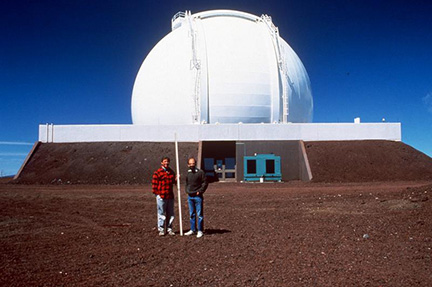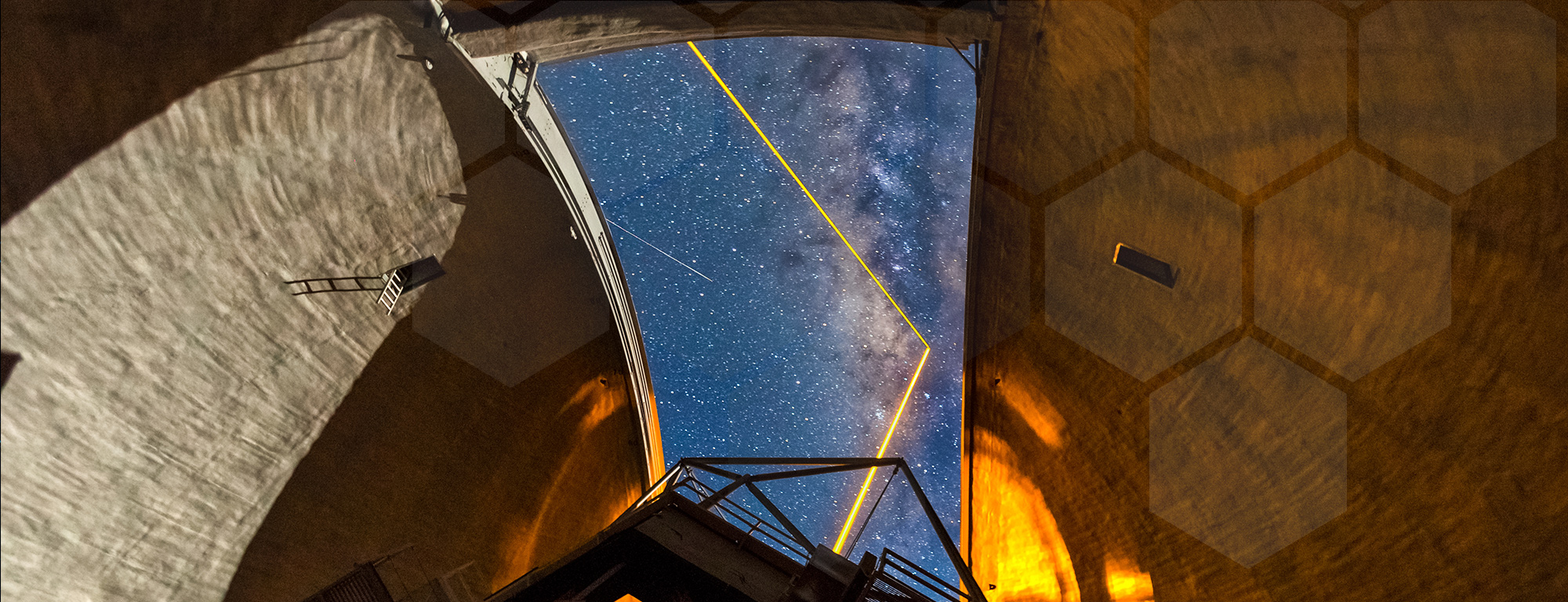Remembering a legend, pioneer, and father of the W. M. Keck Observatory telescopes
“You can’t. It’s never been done. It’s impossible,” they said.
But Jerry Nelson believed he could. He did. And he proved that it is possible.
“He was a giant. Even if you didn’t really know him, you could just feel that this guy was a genius,” said W. M. Keck Observatory principal engineer Dennis McBride, who worked with Nelson on commissioning the Keck I telescope in the early ‘90s.
“When he walked into the room, you just knew it. So many people said that it would not work, including some of our astronomers, but they were all wrong. It works spectacularly well.”
As the mastermind behind the revolutionary segmented primary mirror design of Keck Observatory’s10-meter twin telescopes on Maunakea, Hawaii, Nelson, an astronomer and astrophysicist at the University of California, Santa Cruz, significantly transformed the landscape of modern astronomy, catapulting scientists into a cosmic arena where they could peer far deeper into space than ever imaginable.
And he succeeded in doing so with such intellectual rigor, that to this day, more than 30 years later, Nelson’s invention continues to push astronomical boundaries by way of the next generation of the world’s largest telescopes – many of which are modeled after his segmented mirror design, including the planned 39-meter European Extremely Large Telescope, the Thirty Meter Telescope, and the James Webb Space Telescope.
“I think eventually, people will note him in history as being one of the people who made one of the major advancements in astronomy since Galileo’s telescope,” said Barbara Schaefer, retired observing support coordinator at Keck Observatory who worked with Nelson during his time as project scientist for the Keck Observatory telescopes.
“He defined how astronomy was going to be done at least for the next 100 years, if not longer,” added McBride.
Prior to Nelson’s breakthrough design, optical telescopes had monolithic reflecting mirrors. At the time, the Hale Telescope on Mount Palomar near San Diego boasted the largest one in the United States, with a primary mirror measuring five meters in diameter.
Doubling that size would have made for a mirror that was too heavy – the larger the mirror’s surface, the thicker it must be to prevent gravity from altering its shape. And the heavier the mirror, the costlier the project.
“Scaling up was a really bad idea,” Nelson once explained. “Thermal and gravitational problems make it completely impractical. But making something big out of small pieces is everywhere. Like tiling: The Greeks and Romans tiled everything. I was amazed at the astronomers who just had zero confidence that this would work. They all said it was impossible.”
In 1977, the “Impossible Telescope” was born out of a concept that Nelson, then an astrophysicist at the Lawrence Berkeley National Laboratory (LBL), pioneered. He crafted a mirror design consisting of 36 small, thin, hexagonal segments that perform together with nanometer accuracy as a single piece of reflective glass.

The light-gathering power of these mirrors enables astronomers to see cosmic phenomena more than 10 billion light years away from Earth, and has triggered a domino-effect of ground-breaking discoveries, from the supermassive black hole at the center of the Milky Way, to Earth-like exoplanets that may potentially have life, ancient galaxies, ultra-distant supernovae, and more.
“There would be no 10-meter telescopes without Jerry Nelson,” said Peter Wizinowich, chief of technical development at Keck Observatory, who worked with Nelson as the optics engineer shortly after Keck I was built.
“What impressed me most about him was that, looking back, he was just in his 30’s. It wasn’t only about solving the problems, but convincing the powers that be to fund the project. He had the whole range of skills to make it happen. Nelson came across as brilliant, but personable. He could get along with anyone,” Wizinowich said.
“He was easy to work with, always smiling, always an incredible optimist,” said Mark Sirota, who worked with Nelson as Electronics Engineering Manager in Keck Observatory’s early years. “He was actually extremely competitive, but in a way that you never really knew until you got to know him better. Nelson was somehow extremely disciplined and determined, but he did it in a manner that was completely amazing. I don’t know anyone else like that.”
Nelson was notorious for his infamous line, ‘I don’t understand’- a mild way of signaling that you were about to fall under intense scrutiny.
“As soon as he said that you knew you were in trouble because he could figure out if you knew what you’re talking about. And if you didn’t, he would pick up on it immediately. But instead of saying, ‘no that’s not right,’ he just had this way of gently letting you know that you
should go back and think about what you’re saying again,” said McBride.
“Jerry could always nail you if he wanted to. In a meeting, if he really wanted to challenge you, he could really probe a design or someone’s argument and it would be tough to stand up to that argument. But he’d always start in a subtle, nice way,” said Wizinowich.
According to Schaefer, his approach and character are what set Nelson apart from other top names in the field. He was humble, down-to-earth, and had genuine respect for everyone.
“He wasn’t in it for his own glory, he was in it to figure out how to make the telescope work. That was all he cared about – solving the problems and creating something that people could use to solve the mysteries of the universe,”she said.
Mastering the segmented technology to do so required much brain power, and right by Nelson’s side to help him was the late Dr. Terry Mast, a research physicist at the University of California Observatories.

“He and Terry were inseparable,” Schaefer said. “You always said ‘Jerry and Terry.’
“I always think of them as very close together,” said Wizinowich. “Because together, they were probably a lot more powerful than either of them individually.”
Perhaps the duo’s greatest power was having a strong sense of teamwork.
“It didn’t matter if you had a PhD or if you were a student – they had respect for everybody. There wasn’t a ‘them’ or an ‘us’ – that was the day-to-day feeling of that office. Everyone was equally a part of this big exciting project and it made for a really amazing environment to work in. You don’t always find that from people who are at the top of the field,” said Schaefer.
Nelson, a member of the National Academy of Sciences, certainly was at the very top, with a resume impressively littered with prestigious awards and high honors, including the 2010 Kavli Prize in Astrophysics, the Benjamin Franklin Medal in Electrical Engineering, the André Lallemande Prize of the French Academy of Sciences, and the Dannie Heineman Prize for Astrophysics of the American Astronomical Society.
The accolades for his achievements extend beyond Nelson’s work as telescope designer. He also was a trailblazer in the field of adaptive optics.
As the founding director of the Center for Adaptive Optics at UC Santa Cruz, Nelson was at the forefront of arming astronomers with a system that would give them an unprecedented, ultra-sharp view of the cosmos.
What was the secret to his success? Nelson, a Caltech alumnus who received his PhD in physics from UC Berkeley in 1972, had a knack for untangling sophisticated problems by simply – yet meticulously – going back to the basics.
“When he looked at a problem, he would always go back to what he would call Freshman physics, and he would solve the problem from the very beginning,” said Schaefer.
“Other people would often just take something at face value or believe what so-and-so said, but Nelson was always going back to fundamental principles to make sure he not only understood how things worked, but really believed it,” she said.
“Nelson was able to quickly understand the core issues when problems surfaced; he knew how to see through the noise and extract what was relevant,” said Sirota. “He taught me to think in ways that I never would have learned on my own.”

Even after suffering a stroke in 2011, Nelson powered through the physical aftermath. He continued to work with unrelenting purpose and passion. Most recently, he served as project scientist for the planned Thirty Meter Telescope.
On June 10, early Saturday morning, Nelson passed away in his sleep at the age of 73.
Nelson is survived by his wife, Jocelyn Nelson; his sister Jeanne Moat; two children from his first marriage, Leif and Alexandra; and three grandchildren. His first wife Victoria died in 1992.
Nelson also leaves behind his Keck Observatory ohana, who sorely misses the slipper-wearing, ocean-loving waterman who frequently swam from Mauna Kea Beach to Hapuna Beach during his time on the Big Island of Hawaii.
He inspired everyone in his orbit, as a veteran scientist, mentor, colleague, and personal friend.
“Jerry held up the beacon of excellence, showing us that together we could achieve more than we ever dreamed,” said Keck Observatory director, Hilton Lewis, who worked shoulder-to-shoulder with Nelson since the early chapters of the Observatory’s history.
“We have lost Jerry, but his inspiration and humanity will live on.”
Read more about Jerry Nelson:
- Personal Tribute by Hilton Lewis, director of W. M. Keck Observatory, featured in Scientific American
- Tribute by UC Santa Cruz
- Tribute by Caltech
- Tribute by SETI Institute
About W. M. Keck Observatory
The W. M. Keck Observatory operates the most scientifically productive telescopes on Earth. The two, 10-meter optical/infrared telescopes on the summit of Maunakea on the Island of Hawaii feature a suite of advanced instruments including imagers, multi-object spectrographs, high-resolution spectrographs, integral-field spectrographs, and world-leading laser guide star adaptive optics systems. The Observatory is a private 501(c) 3 non-profit organization and a scientific partnership of the California Institute of Technology, the University of California, and NASA.


